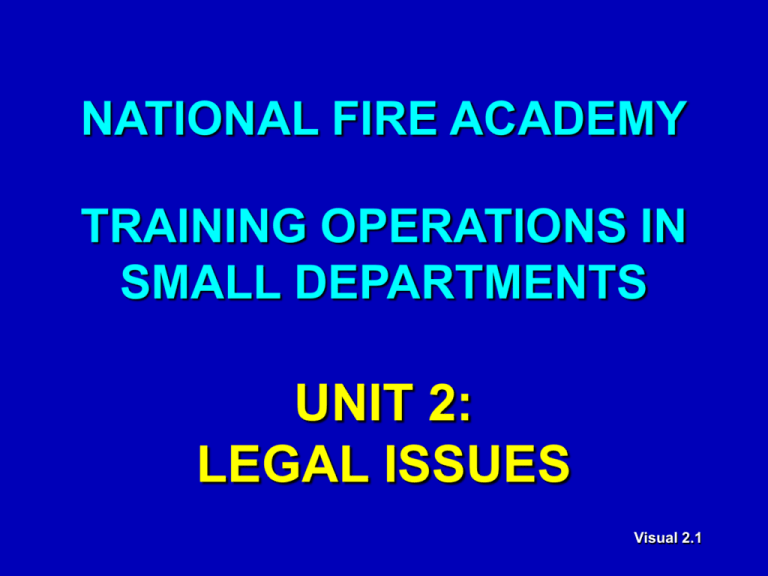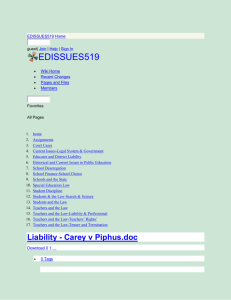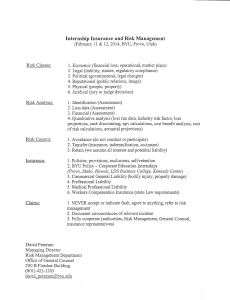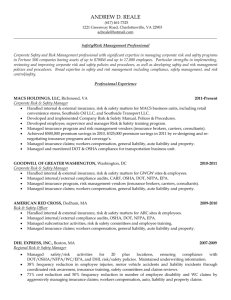UNIT 2 - LSU Fire and Emergency Training Institute
advertisement

NATIONAL FIRE ACADEMY TRAINING OPERATIONS IN SMALL DEPARTMENTS UNIT 2: LEGAL ISSUES Visual 2.1 GOALS • To identify legal issues affecting the Training Function. • To develop a training documentation plan that assures compliance with legal, liability, and certification documentation requirements. Visual 2.2 TERMINAL OBJECTIVES The students will be able to: • Analyze the degree of compliance in their own departments with respect to legislation and Federal regulations. • Design a training documentation management plan suitable for use in their own departments. Visual 2.3 LEGAL ISSUES IN TRAINING Minimizing legal liability: • Do the right thing • Have documentation to prove it • Meet moral obligations Visual 2.4 ETHICS FOR THE TRAINING FUNCTION • • • • Challenging Public values Support Individual personal standards Visual 2.5 ETHICS FOR ORGANIZATIONS The five basic principles of ethics for organizations: • Purpose • Pride • Patience • Persistence • Perspective (Blanchard and Peale, The Power of Ethical Management) Visual 2.6 EFFECTIVE LEADERS MUST • Recognize that the fire service has a special public trust • Set the tone for ethical and legal decisions • Model the expected behavior • Lead through the minefields Visual 2.7 PROVIDING LEADERSHIP FOR ETHICAL BEHAVIOR • • • • • • • Use self-education resources. Read professional journals. Take classes on ethical issues. Develop a code for the Training Function. Reward employees for telling the truth. Produce accurate and timely records. Accept responsibility for communicating information that may be uncomfortable to the recipient. Visual 2.8 LEGISLATION RELATED TO PERSONNEL MANAGEMENT Visual 2.9 DISCRIMINATION People or groups of people treated differently because of some characteristic (e.g., age, race, sex, religion, marital status, national origin). Visual 2.10 DISCRIMINATION ISSUES • • • • • Race or national origin Maternity and family medical leave Age Religion Disability Visual 2.11 HEALTH AND SAFETY • Responsibility for compliance rests with employers. • Occupational Safety and Health Act (OSHA). Visual 2.12 OTHER LEGISLATION • Access to personnel files • Drug and alcohol testing • Copyright/Plagiarism Visual 2.13 FEDERAL REGULATIONS • Train all personnel to the minimum level of competency required by applicable regulations. – Your Standard Operating Procedures (SOP's) form the basis for training • Fire departments must deliver and certify adequate and timely training based on applicable standards. Visual 2.14 FEDERAL REGULATIONS (cont'd) • Departments can be cited for lack of training, documentation, or compliance. • If your agency adopts a standard, it can be enforced. Visual 2.15 FEDERAL REGULATIONS (cont'd) • Develop a compliance plan that deals with your department's greatest needs • Have a realistic view of your department's capabilities Visual 2.16 SAFETY • Train to minimum competency using safe practices. • Trainer liability--failure to do so. Visual 2.17 OSHA REGULATIONS • Protect employees from accidental injury or harm. • Not "nice to do"; they must be enforced. • If you violate OSHA regulations, legal action can be taken. Visual 2.18 NON-OSHA STATES • Know your respective State regulations. • Follow these regulations. • Become familiar with EPA 311. Visual 2.19 NATIONAL FIRE PROTECTION ASSOCIATION STANDARDS THAT AFFECT TRAINING Although not mandated unless adopted by the Authority Having Jurisdiction (AHJ), regulatory agencies are beginning to require compliance. Visual 2.20 VIDEO "Standards and Their Influence on Safety and Health" Visual 2.21 LIABILITY Liability results from a failure of duty. Visual 2.22 VICARIOUS LIABILITY Employers are responsible for actions of their employees. Visual 2.23 NEGLIGENCE Failure to do something that a reasonable and prudent person would do, or doing something that a reasonable and prudent person would not do. Visual 2.24 ELEMENTS OF NEGLIGENCE • • • • Duty--owed or assumed Breach of that duty Causation Damage Visual 2.25 DEFENSE AGAINST LIABILITY Perform your duties within reasonable guidelines or established standards, and document what you did. Visual 2.26 TRAINING LIABILITY ISSUES • Method of instruction • Compromise safety for realistic training • Liability defenses • Responsibility for injuries Visual 2.27 DOCUMENTATION Visual 2.28 REASONS FOR DOCUMENTATION • • • • Satisfy legal requirements. Reduce liability exposure. Verify certification. Justify additional resources. Visual 2.29 REASONS FOR DOCUMENTATION (cont'd) • Verify type and amount of training. • Verify when and where training occurred. • Verify conditions of training. • Verify outcome of training. Visual 2.30 DOCUMENTATION ATTRIBUTES • • • • • Complete Pertinent Accurate Timely Neat Visual 2.31 Activity 2.1 Using Documentation and Records Visual 2.32 SUMMARY • Legislation and governmental regulations increase exposure to liability. • Performing training within standards reduces this exposure. • Documentation reduces exposure by proving what happened. • Documentation can be used in a needs assessment for training in the fire department. Visual 2.33







